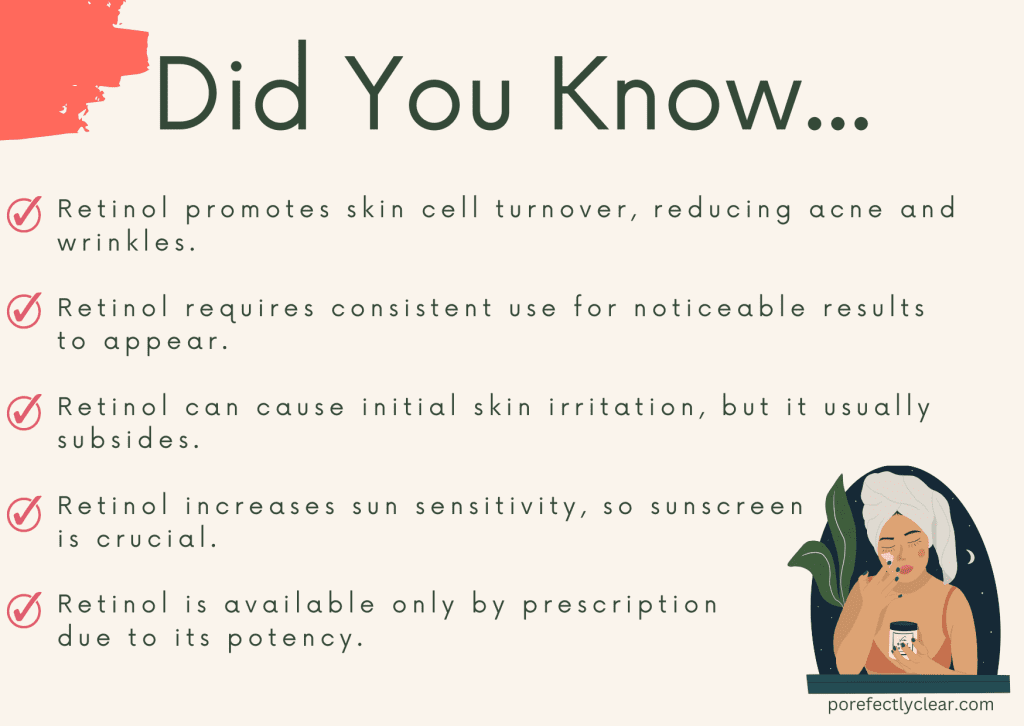Retinol and hyaluronic acid are two of the most popular skincare ingredients out there. While both have their unique benefits, what happens when you use them together? Can it lead to problems? The good news is that you can safely use retinol and hyaluronic acid together with a little bit of know-how.
We dive deep into the benefits of each ingredient and how they work together to give you glowing healthy skin. We’ll also provide step-by-step guidance on how to use these two ingredients in your skincare routine to avoid any negative side effects. From proper skin cleansing techniques to considerations for products that contain both ingredients, we’ve got you covered. So if you’re ready to take your skincare game to the next level, let’s get started!
Understanding Hyaluronic Acid
Hyaluronic acid, a moisture-binding ingredient, holds up to 1000 times its weight in water, benefiting all skin types. It helps smooth fine lines and wrinkles, promoting a plump, firm appearance, while supporting collagen production for elasticity and firmness.
Incorporating hyaluronic acid serum can enhance the skin’s moisture and hydration levels, providing essential care for the skin. When using hyaluronic acid, it’s important to follow the rule of thumb to always apply SPF to protect the skin from potential sun damage.
The Role and Advantages of Hyaluronic Acid in Skincare
Maintaining skin moisture, and improving dryness and dehydration, hyaluronic acid promotes smoother skin texture, reducing the appearance of fine lines and wrinkles. It helps counter retinol’s potential irritation, making it suitable for sensitive skin, benefitting cell turnover, and achieving a more even skin tone. Incorporating hyaluronic acid serum in a skincare routine benefits all skin types, ensuring optimal hydration and improved skin texture. This essential NLP term combines seamlessly with other skincare ingredients, enhancing the overall health and appearance of the skin.

Potential Side Effects of Hyaluronic Acid
While hyaluronic acid typically offers numerous benefits for skin care, it’s important to be mindful of potential side effects. Rare occurrences of redness, itching, or skin irritation may arise. Overuse of hyaluronic acid serum can even lead to skin dryness, negating its hydrating effects.
To prevent adverse reactions, it’s essential to patch-test skin care products containing hyaluronic acid. In some instances, hyaluronic acid may trigger breakouts, particularly for those with acne-prone skin. Consulting a dermatologist is always the best rule of thumb when it comes to concerns about side effects.
Understanding Retinol
Retinol, a derivative of retinoic acid, facilitates increased cell turnover for smoother skin. Known for reducing dark spots and hyperpigmentation, retinol serums effectively reduce wrinkles and fine lines. This skincare ingredient also aids in acne management by minimizing breakouts and blemishes, contributing to a more even skin tone. When incorporating retinol, remember the rule of thumb: apply SPF during the day to protect your skin from potential sensitivity to sunlight.
Why Retinol is Essential for Skin Health
Retinol plays a vital role in stimulating collagen production, promoting firmness and elasticity in the skin. Its regular use can effectively combat sun damage, reducing the appearance of wrinkles and fine lines. Additionally, retinol benefits the skin barrier, enhancing its ability to retain moisture, and making it ideal for dry skin types. These moisturizing effects make retinol a valuable addition to skincare routines, with the rule of thumb being to start with lower concentrations to minimize the chance of irritation.

Possible Side Effects of Retinol Usage
When using retinol products, it’s essential to apply sunscreen as they can increase the skin’s sensitivity to sun damage. Overuse of retinol may result in redness, dryness, or flakiness, indicating irritation, while initial usage may cause temporary breakouts during skin cell turnover. To minimize the chance of irritation, it’s recommended to start with a pea-sized application. It’s normal to experience some redness, dryness, or irritation, especially during the initial usage of retinoids.
Why Pair Hyaluronic Acid and Retinol?
Pairing hyaluronic acid and retinol can enhance the skin’s moisture and hydration, benefiting the skin’s moisture barrier. When used together, these ingredients work synergistically to supplement the skin’s hydration, resulting in improved overall skin health.
Potential Risks of Combining Hyaluronic Acid and Retinol
While combining hyaluronic acid and retinol, there is minimal chance of irritation, as indicated by the beauty industry. It is recommended to patch test when using these skincare ingredients together to minimize any potential irritations.
The chances of experiencing irritation from the combination of hyaluronic acid and retinol are very low, making it a safe practice for most individuals. This rule of thumb helps protect the skin and maintain its health. Remember to follow up with SPF when using retinol during the day to protect the skin from sun damage.
Detailed Steps to Use Hyaluronic Acid and Retinol Safely
Proper skincare begins with gentle cleansing to prepare the skin. Following this, a pea-sized amount of retinol should be applied, avoiding sensitive areas. Hyaluronic acid serum or moisturizer can then be applied to provide the skin with hydration and moisture.
It’s recommended to use warm water for cleansing to prevent skin dryness. If irritation persists, consider substituting retinol serums or consult a dermatologist. These steps ensure the safe and effective use of retinol and hyaluronic acid together, maintaining skin health and moisture balance.

Step 1: Proper Skin Cleansing
To begin, select a gentle cleanser suited to your skin type to remove impurities without stripping away moisture. Clean, hydrated skin ensures efficient retinol absorption and helps prevent potential irritation. Avoid cleansers with ingredients that may counteract retinol’s benefits, such as harsh exfoliants. Properly cleansing your skin, especially in the evening, sets the foundation for effective retinol application. Remember, maintaining skin moisture and hydration post-cleansing is essential for retinol’s optimal function.
Step 2: Application of Retinol
To optimize retinol’s efficacy, apply a pea-sized amount to prevent wastage and minimize skin irritation. Once absorbed, retinol targets dark spots, fine lines, and wrinkles—avoid sensitive areas to minimize redness and irritation. New users should start with lower concentrations and gradually increase application frequency. Sunscreen during the day maximizes retinol’s benefits by reducing sun damage. This ensures that the skin is adequately protected and that retinol’s effects are fully realized.
Step 3: Follow up with Hyaluronic Acid Serum or Moisturizer
Post-application of retinol, incorporate hyaluronic acid serum to replenish moisture and counteract dryness, preventing potential side effects like redness and irritation. Suitable for all skin types, the serum enhances skin elasticity and firmness. Follow with a moisturizer to seal in moisture and maintain hydration levels, essential for preventing dryness, redness, and breakouts post-retinol use. This step aligns with the rule of thumb in skincare – always apply SPF during the day to protect the skin.
Considerations When Your Retinol Product Contains Hyaluronic Acid
Hyaluronic acid attracts moisture to the skin, enhancing hydration, while retinol may enhance these benefits, aiding in moisture retention. The combination of retinol and hyaluronic acid can significantly improve the skin’s hydration and benefit its moisture barrier. This combination is particularly beneficial for addressing dryness and fine lines, making it a vital addition to any skincare routine. Remember, as a rule of thumb, always use SPF during the day when using retinol to maximize its benefits and reduce the risk of sun damage.
Other Beneficial Ingredients to Combine with Retinol
Niacinamide
Using niacinamide with retinol, a derivative of vitamin B, pairs well with retinol, enhancing its benefits for skin texture and tone. Antioxidants, like vitamin C, boost retinol’s effects on skin tone and combat free radicals. Peptides work synergistically with retinol to support collagen production, promoting skin firmness and elasticity. Ceramides, as skin barrier protectors, help minimize retinol-induced irritation, maintaining skin’s moisture levels. Additionally, incorporating sunscreen with retinol helps prevent sun damage and redness while ensuring skin protection.
Collagen Peptides
Enhancing skin firmness and smoothness, collagen peptides have valuable benefits. These peptides help improve skin elasticity, firmness, and hydration. Moreover, they can enhance complexion, providing a better skin tone and texture. By supplementing the dermis, collagen peptides play a vital role in improving skin appearance and hydration. When considering skincare ingredients, collagen peptides are a key factor in maintaining healthy and moisturized skin.
Ceramides
Ceramides, as skin barrier protectors, play a crucial role in maintaining the skin’s moisture and hydration levels. By using ceramides, the skin barrier’s hydration can be effectively preserved, thus preventing moisture loss and dryness. Additionally, ceramides contribute to the skin barrier’s smoothness, supplementing the skin’s moisture and firmness. Moreover, they aid in enhancing the skin barrier’s elasticity, thereby supplementing the skin’s hydration and smoothness, ultimately improving the skin’s overall appearance and firmness.
Is it Safe to Use Retinol and Hyaluronic Acid Together?
Yes, it is safe to use retinol and hyaluronic acid together in skincare products. The combination of these two ingredients provides enhanced benefits for the skin. Skincare experts often recommend using products that contain both retinol and hyaluronic acid for optimal results.
Conclusion
It is safe to use retinol and hyaluronic acid together, as long as you take certain precautions. Both ingredients offer unique benefits to the skin and can complement each other when used properly. Remember to start slow and gradually introduce retinol into your skincare routine to allow your skin to adjust.
It’s also important to properly cleanse your skin before applying retinol and follow it up with a hyaluronic acid serum or moisturizer to provide hydration and support the skin’s barrier function. Additionally, consider incorporating other beneficial ingredients like collagen peptides and ceramides for enhanced results.
By following these steps and considering the compatibility of your skincare products, you can safely enjoy the benefits of both retinol and hyaluronic acid for healthier, more youthful-looking skin.





